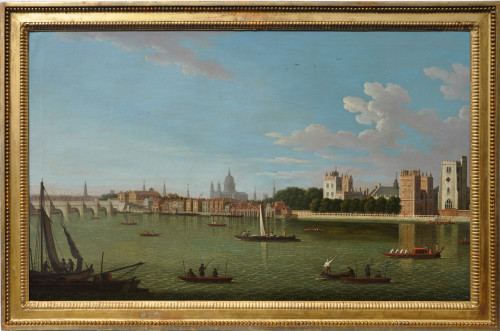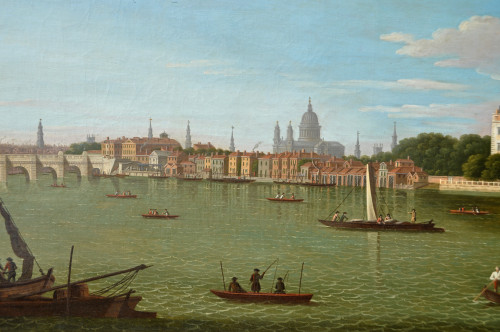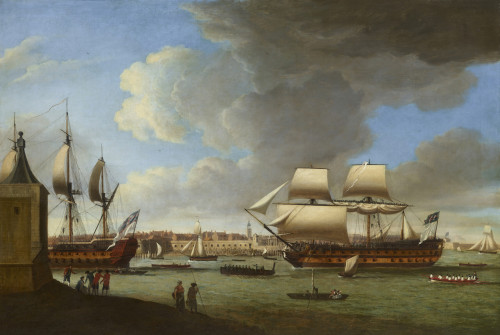A view of the Cascade in the garden of Sir Francis Dashwood’s West Wycombe Park with a view to the house to the left and the hilltop church of St Lawrence’s at West Wycombe to the right
A view of the Cascade in the garden of Sir Francis Dashwood’s West Wycombe Park with a view to the house to the left and the hilltop church of St Lawrence’s at West Wycombe to the right
Attributed to W TAYLOR
Mid 18th century
English School
A view of the Cascade in the garden of Sir Francis Dashwood’s West Wycombe Park with a view to the house to the left and the hilltop church of St Lawrence’s at West Wycombe to the right
Oil on canvas
96.5 x 152.5 cms
38 x 60 inches
Ex. Collection: David Pleydell-Bouverie, grandson of the 5th Earl of Radnor
The painter W Taylor is unknown in that where he was based and his dates are unrecorded. However, there is one painting of Stanway House in Gloucestershire, signed and dated 1748, which bears striking similarity to the treatments in this work. The Stanway painting, described by John Harris, in his The artist and the Country House, as: “This attractively naïve view might suggest a local painter from Gloucester or Cheltenham…” The colouration, depiction of the trees and foliage and the staffage all bear comparison in both paintings.
Bibliography: The Artist and the Country House – John Harris
The Dictionary of British Eighteenth Century Painters – Ellis Waterhouse
WEST WYCOMBE PARK
The house at West Wycombe Park was built between 1740 and 1800 and was designed to be where Sir Francis Dashwood, the renowned 18th century dilettante and libertine, could indulge his friends and himself. It is a unique design with architectural quirks but it exemplifies the transition in 18th century Britain from Palladian to Neoclassical.
Sir Francis inherited the house from his father in 1724 and between 1726 and 1741 the former undertook several Grand Tours which informed his taste and aspirations throughout his life. He had his father’s rather simple red-brick Queen Anne style house redesigned in the classical manner with references to the Palladian and Veneto styles.
It sits within a contemporaneous landscaped park which contains many follies and small temples. The gardens at West Wycombe are extraordinary and along with Stowe Park, is one of the finest to survive in England from the 18th century. It has a large number of classically inspired buildings and follies which reference those from Italy and Greece. The design was undertaken by Thomas Cook, who was responsible for landscaping the garden and Nicholas Revett who worked more on the ornamental features. There was a ready source of water with the river Wye close to the park and it was Cook who took advantage of this and conceived the lake which covered nine acres and took the form of a swan. The replenishing of water is constant as it flows in from the river and out down the cascade and into a canal at a lower level.
The lake had islands to create perspective and added intrigue and one of these had a Temple of Music in which Sir Francis staged theatrical delights and fêtes champêtres. The temple was based on the Temple of Vesta in Rome. The size of the lake meant that it was large enough to have a boat and this sailing vessel came complete with its own captain and it had several cannon that were fired regularly to add to the excitement.
Dashwood’s guests could enjoy the 5,000 acres of the gardens and park and as a consequence of the design and landscaping, would be taken on a journey of discovery as they would be drawn from one tantalising vista to another with glimpses of follies or water features leading the walker onwards.
The caves, excavated into the hill, are the largest man-made 18th century landscape devices in England. There is a smaller one at Stowe and Sir Horace Walpole had built one at Strawberry Hill but nothing else matched Dashwood’s enterprise. The entrance had a gothic style arch made of flint with niches for statues. The visitor passed symbolic rooms and statues as he progressed ever deeper before traversing a subterranean stream known as the Styx. Once crossed, ahead lay the Inner Temple, the largest and most important part of the complex and it is allegedly 300 feet directly below St Lawrence’s Church which sits atop the hill.
It is in the West Wycombe Caves that Sir Francis established the notorious Hellfire Club. There had been a chalk quarry on the adjacent hillside for centuries and between 1748 and 1752 Sir Francis utilised it to provide materials for local road building but he also had a tunnel dug back into the hill. This served no useful purpose in relation to the chalk provided when set against the time and cost of undertaking so it was an indulgence. It was about 450 yards long with passages leading off from the main tunnel which led to chambers and one very large room, the Inner Temple, at the end.
Sir Francis had founded the Society of Dilettante in 1733 with the intention of spreading the interest in classical art and architecture. It would seem that Dashwood’s passion for classical times was commensurate with his disdain for the strictures of Roman Catholicism. Over the ensuing years, when back in England, he mockingly commissioned several portraits of himself in the guise of leading Catholic clergy. Hogarth depicted him as a Franciscan friar gazing lasciviously at a statue of Venus, Adrien Carpentiers showed him as Pope Pontius VII in the act of toasting a statue of Venus, Nathaniel Dance as a monk and George Knapton interpreted him as San Francisco di Wycombo admiring another Venus.
In about 1750, Dashwood, in addition to the joint founding of the society above and founding the Divan Club in 1744 for those who had visited the Ottoman Empire, inaugurated the Brotherhood of St Francis of Wycombe, (or The Order of the Friars of St Francis of West Wycombe or Order of Knights of West Wycombe according to Horace Walpole). It was later known as the Hellfire Club. The motto of the club was borrowed from the great French satirist Rabelais and states: “Fais ce que tu voudras” – “Do what thou wilt”. Its first meeting at West Wycombe was on the propitious day of Walpurgis Nicht in 1752. The club convened twice a month with a week-long AGM in the summer. The membership was comprised of aristocrats and leading figures from society at the time as well as artists such as William Hogarth, poets, politicians, diplomats and Benjamin Franklin was an occasional attendee. Because of its exclusivity and unusual location, speculation as to what went on at the meetings abounded. There was talk of wild orgies, demonic rituals and dabbling in the black arts. There is still much conjecture as what indulgencies and revels occurred at the meetings and certainly the behaviour was unusual for the 18th century, but while there was considerable drinking, enacting of satirical parodies of religious ceremonies and some sexual exploits, it is likely that the wilder extremes of bacchanalia mentioned were an exaggeration.
The MP John Wilkes wrote that the main purpose of the club was “:…a set of worthy, jolly fellows, happy disciples of Venus and Bacchus, got occasionally together to celebrate woman in wine and to give more zest to the festive meeting, they plucked every luxurious idea from the ancients and enriched their own modern pleasures with the tradition of classic luxury.” Horace Walpole maintained that: “…practice was rigorously pagan Bacchus and Venus were the deities to whom they almost publicly sacrificed; and the nymphs and the hogsheads that were laid in against the festivals of this new church, sufficiently informed the neighbourhood of the complexion of those hermits.”
Despite this unconventional lifestyle, Sir Francis was active in politics throughout his life and in later years particularly set aside more of his time to charitable causes, giving employment to local people and to initiating political reform. In 1762 the Prime Minister made Dashwood his Chancellor of the Exchequer despite, as one critic put it, that Sir Francis would have difficulty interpreting “…a bar bill of five figures.” It was during this period that the Hellfire Club went into decline, partly as a consequence of scandal attached to some of the members, and by 1766 it was no more. Sir Francis Dashwood died in 1781, leaving the estate to his half-brother Sir John Dashwood-King.
RELATED ITEMS






















